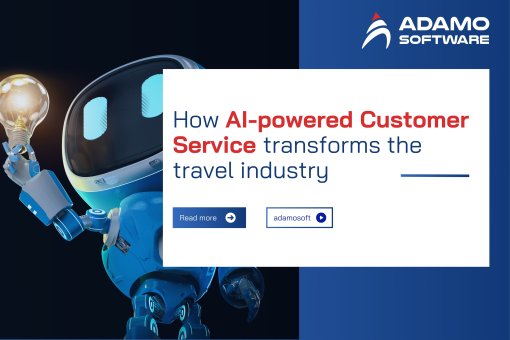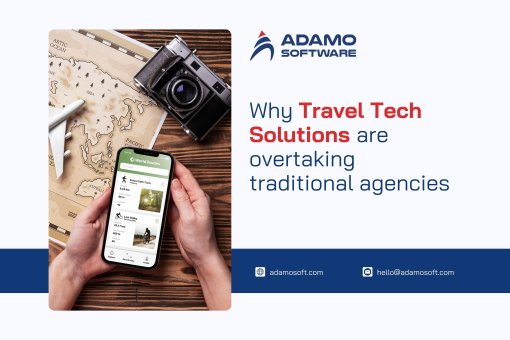How to build Corporate Travel Booking Software that boosts efficiency
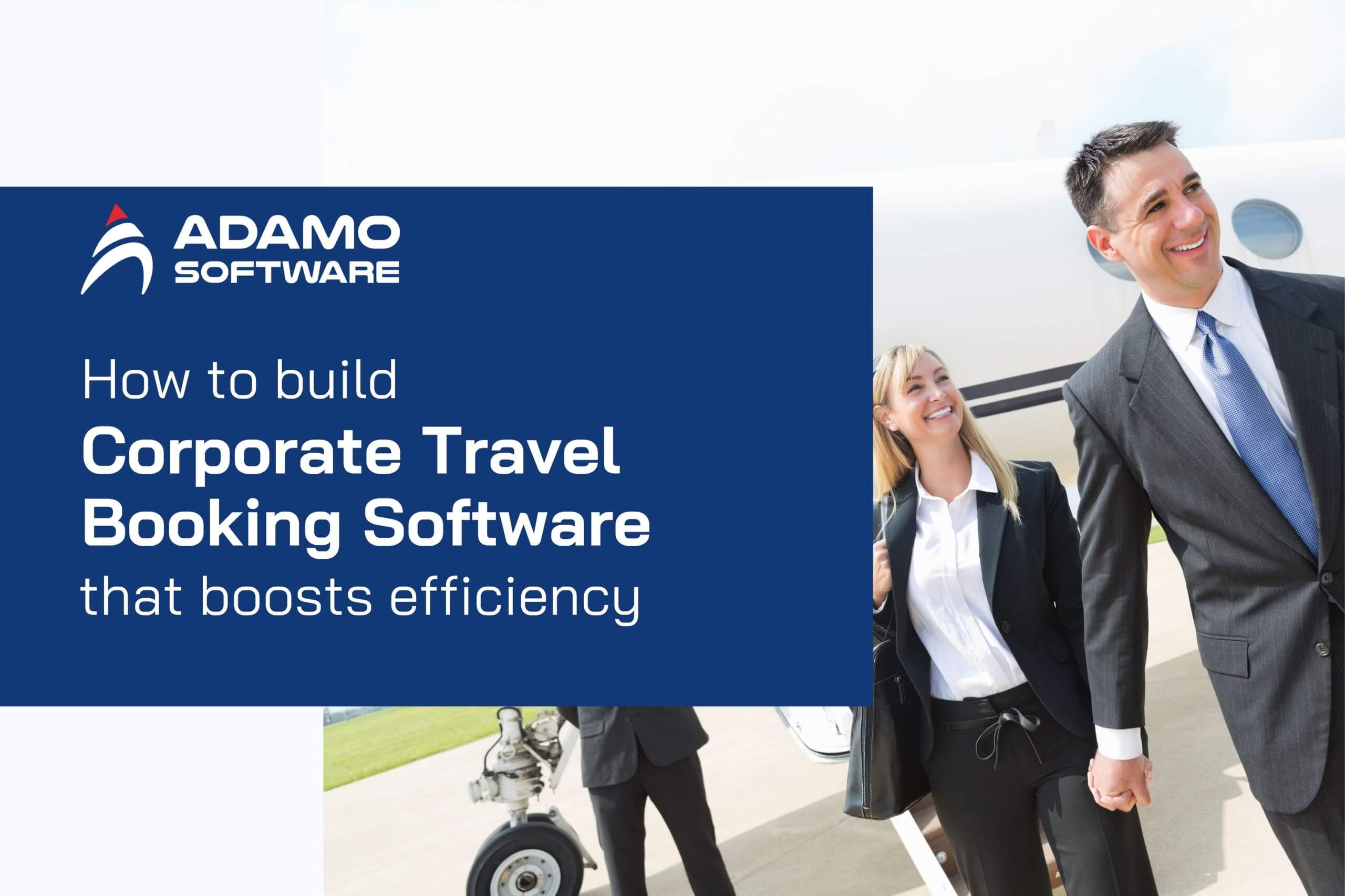
Learn what features matter in Corporate Travel Booking Software and how to design one that fits your company’s needs and keeps teams moving.
Corporate travel is a very demanding procedure. Companies spend too much time and money on arranging travel that is not consistent and controllable, especially when it involves booking flights and hotels and tracking travel expenses. Corporate Travel Booking Software is an online tool that aims to simplify every aspect of the business travel process.
Since the Global Business Travel Association (GBTA) expects corporate travel spending worldwide to reach 1.4 trillion dollars in 2024, it is a good sign that corporate travel spending increased during the peak season. Against this backdrop, organizations urgently need to invest in smarter travel management tools. Properly constructed Corporate Travel Booking Software assists in decreasing expenses, enhancing policy agreement, and facilitating trips for travelers and travel managers.
The purpose of this article is to teach you what kind of features should be present in the powerful Corporate Travel Booking Software, how to create one piece by piece, and what restrictions to be aware of. Do you have a blank platform to build or an existing system to optimize? The roadmap described here will put you on the right path.
I. What to include in a Corporate Travel Booking Software
A good Corporate Travel Booking Software should not be limited to making reservations. It should lower manual work, manage costs, and ensure the safety of travelers. Software must be automated, visible, and flexible to support the increased business travel in 2026.
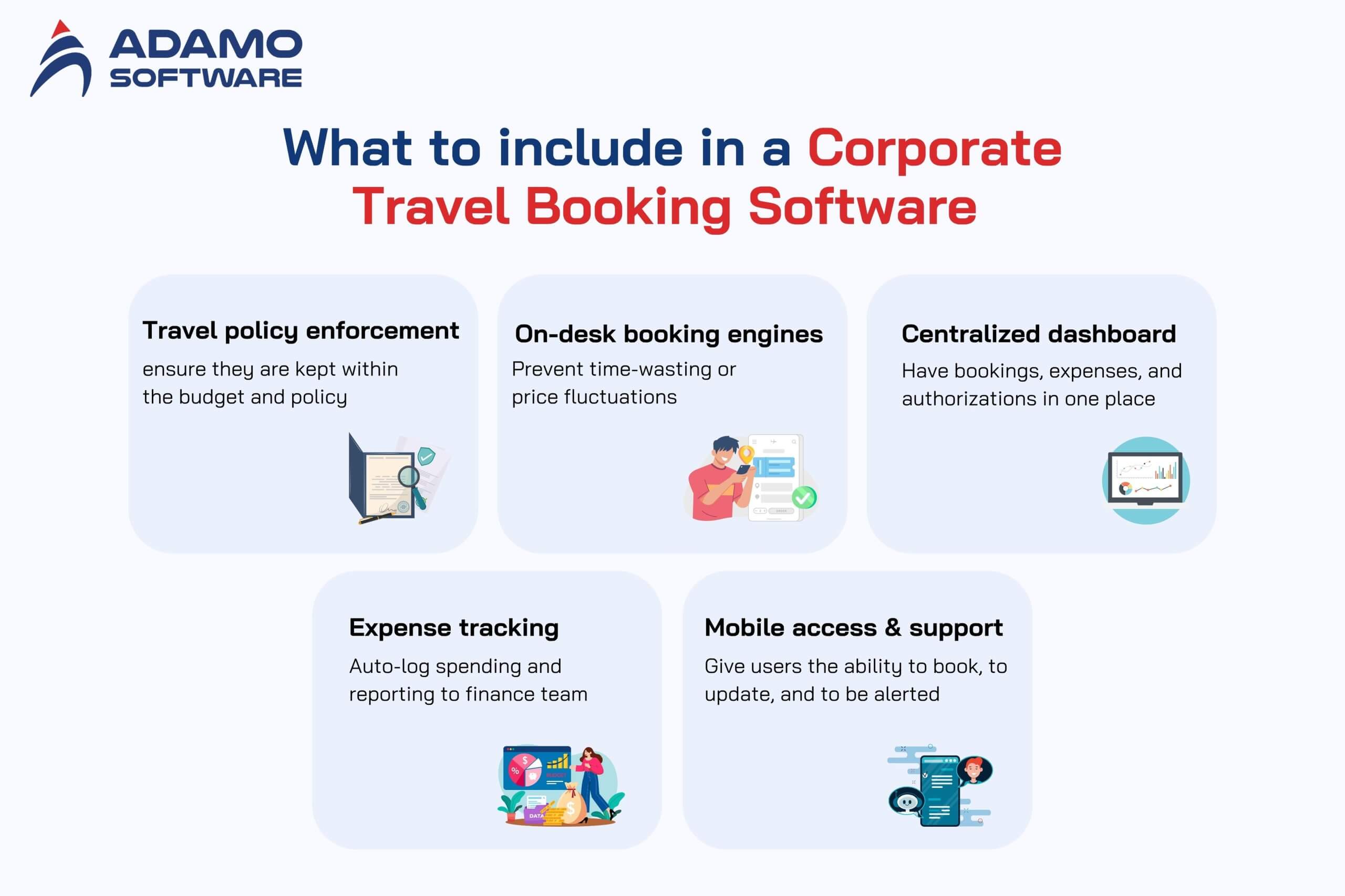
The following are the most important features that a Corporate Travel Booking Software should have:
- Travel policy enforcement: Automate company policies to ensure they are kept within the budget and policy.
- On-desk booking engines: Show available real-time flights, accommodations, and cars in order to prevent time-wasting or price fluctuations.
- Centralized dashboard: Have all the bookings, expenses, and authorizations in one place to control them easily.
- Expense tracking: Auto-log spending and reporting to the finance team.
- Mobile access and support: Give users the ability to book, to update, and to be alerted anywhere and anytime.
1. Travel Policy Enforcement
Among the most significant roles of Corporate Travel Booking Software, one can outline the fact that the software makes sure that all bookings adhere to the travel policy of the company. When regulations are incorporated within the being ology methodology, i.e. flight seat restrictions, preferred hotel chains, and per-day funds allotted, the employees would no longer have to guess what they can or cannot do. They are steered by preset options that will only pop up non-compliant options.
As indicated in a guide by Booking.com, policy integration has the capacity to limit policy violations and avoid conflicts and friction between the travelers and managers. It also reduces the time on approvals so that booking will be faster and transparent.
A good Corporate Travel Booking Software will also allow setting of different rules for different teams or different levels of seniority. Such flexibility is critical to the large organizations that have diversified travel requirements.
2. Real-Time Booking Tools
Itineraries are subject to rapid change. The strongest Corporate Travel Booking Software should be able to hook up to a real-time flight, hotel, train, and car rentals supply. This will make sure that the information that travelers get is the information about expired deals and unavailable rooms.
Bookings with obsolete information led to additional costs to the company and time wastage to the employees. Through real-time access, the software minimizes errors in booking, saves costs, and eliminates last-minute cases.
Booking.com explains that live rates and availability help make smarter decisions and achieve a smoother process for travelers and admins.
3. Centralized Dashboard
An explicit dashboard is the main console of any Corporate Travel Booking Software. It not only provides employees and travel managers with a view of all upcoming trips, their status in the approval, policy exception, and total amount of expenses, but also in a single place.
This functionality eliminates the use of random emails or spreadsheets. It also assists teams to be organized and respond quickly in case of any changes in plans.
According to Booking.com, centralized visibility assists companies in identifying issues sooner and enhances compliance monitoring.
4. Expense Tracking
Expenses on travel can be easily exceeded during the process if they are not monitored on a real-time basis. An effective Corporate Travel Booking Software will automatically keep a record of travel expenditure as they occur- flight, accommodation, Taxi, food, etc. This assists companies to pay more attention to their expenditure and identify the trends in spending.
It also makes expense reports easier and directly integrates with the accounting software, allowing travelers and the finance department to save time. The Booking.com report if data-centralization assists in appreciating where money is going down the drain and where savings are possible.
5. Mobile Access and Support
Most business travel activities occur when we are not in offices. Corporate Travel Booking Software that is mobile-friendly enables the users to make a reservation or modification or cancellation of the reservations via phone or tablets. It is also able to deliver auto notification of flight delays, gate changes, or alerts due to safety.
The degree of access allows passengers to feel that they are in charge, especially during the unfolding of unforeseen happenings. It also assures businesses with confidence that the employees will get help in any place they are situated.
When combined with the mobile capabilities, Corporate Travel Booking Software turns into a tool that travelers use throughout the whole trip, and not only when making the reservation.
An all-in-one Corporate Travel Booking Software is integrated with automation, transparency, and flexibility. It helps keep the employees on track with policy, minimizes errors, and enhances the seamlessness of travel. With business travel further increasing to achieve $1.4 trillion of business travel around the world by 2026, organizations that invest in intelligent solutions will be in a more favorable position to manage scale and costs. The appropriate Corporate Travel Booking Software not only proves to be helpful but is also vital in travel management of today.
You can explore more about Guide to Build Online Booking Engine for Hotels, Airlines and Travel.
II. 8 steps to build an effective Corporate Travel Software
It is not only the technical development of an effective Corporate Travel Booking Software. It should have a defined framework, contributions from various divisions, and synchronization of business travel. The software must address actual challenges such as manual booking, policy breaches, and tracking expenses; however, finding its way to be convenient is easy.
The following are 8 steps on how to create a winning Corporate Travel Booking Software in 2024:
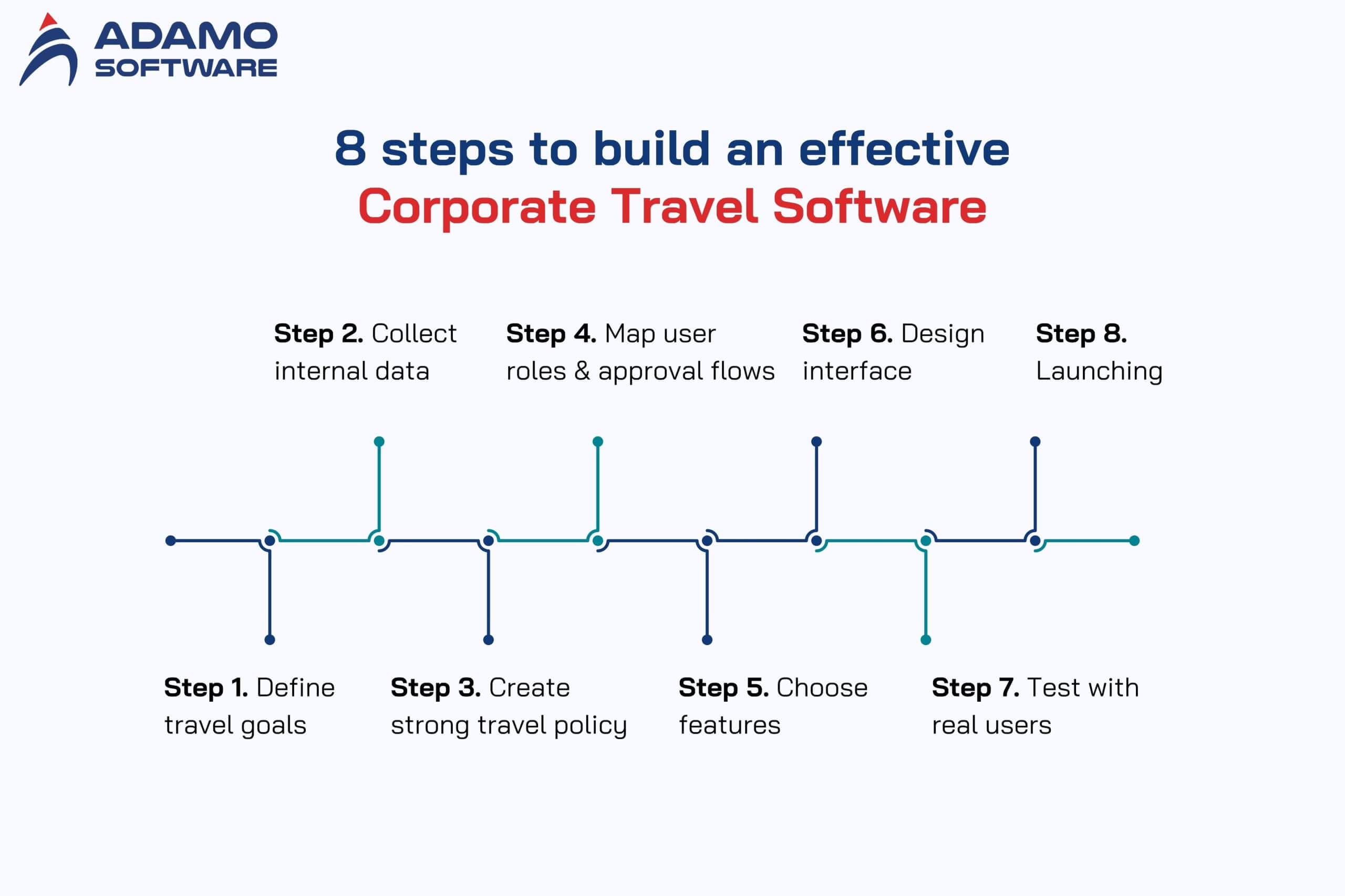
- Set specific travelling targets – Begin with the end in mind
- Gather internal travel information – Where you are broken is where your problems are
- Develop a powerful travel policy – Write your policies before writing code
- Map users and approvals processes on a map – Control who does what
- Select critical capabilities – The pain point solver
- Create an easy-to-use interface – Create a book-and-be-done experience
- Put into the hands of real users – Enhance by listening to real users
- Train and support the launch – Train every user and help lines in case of problems
1. Define Clear Travel Goals
Learn the problem that you are solving before touching the keyboard. Are you cutting down your travel expenses? Faster booking? Fulfillment of policy? The first step to a good Corporate Travel Booking Software is the intent. It must also fit with the travelling objectives of your company and respond: What do we need to change and why?
2. Collect Internal Travel Data
Re-examine previous reservations, invoicing, and customer reviews. This will assist you in knowing what is not working and areas where Corporate Travel Booking Software can have the greatest influence. Seek misinformed charges or slow authorizations or off-policy reservations. Smart software has been used because of real data.
3. Create a Strong Travel Policy
Software is driven by your policy. Set budgeting, booking channels, permitted vendors, and approval levels. The next step is to translate that policy into logic that the system can follow. Corporate Travel Booking Software would only work where it may execute the company policies automatically, and without the need for any manual verification.
4. Map User Roles and Approval Flows
Each user will require a different level of access. There are perceived options which should be seen by workers. Managers are supposed to approve or reject requests. Reporting should be made to the Finance teams in the development of Corporate Travel Booking Software; each role should be clarified. This avoids confusion and having control over the right hand.
5. Choose Essential Features
Do not stuff your system with unnecessary tools. What matters are the essentials: real-time booking, automatic approvals, cost tracking, and mobile access. A specialized Corporate Travel Booking Software has the advantage of being lighter in performance and easier to maintain. You can always add down the line.
Ready to Outsource?
Discover how we can transform your business with expert IT solutions.
6. Design a Simple Interface
Unless the programs are user-friendly, they will not be used because people have other things to do. See that the screens are clean, the steps short, and the language plain. A user-friendly Corporate Travel Booking Software must have the interface of a consumer software, and the control of an enterprise-level software.
7. Test with Real Users
Test with employees before launching the software and not necessarily the developers. To get honest feedback on speed, layout, and easy usability of booking. Teams should test the Corporate Travel Booking Software through test bookings and live situations. Then, what does not work works better.
8. Launch with Training and Support
And even great tools won’t get the job done without proper onboarding. Train every user and help lines in case of problems. The success of Corporate Travel Booking Software has much to do with the fact that it can increase in strength – with updates, feedback cycles, and overall support.
By adhering to these 8 steps, you end up creating Corporate Travel Booking Software that eliminates problems. It is not just automating travel it is reinventing the way your business runs itself. By 2024, when travel systems must be smarter to accommodate increased needs, companies that have invested in user-oriented and policy-latent tools will go farther and remain ahead.
III. Limitations when using Corporate Travel Booking Software
These are the limitations that the most sophisticated Corporate Travel Booking Software software shares. Although it has the potential to automate bookings and cost management, it cannot be used to fully replace human decision-making or to break down policies. In most businesses, the programs would be underutilised or abused not because they lack capabilities but because they are not geared towards the practicalities of traveling.
The following are the limitations that are common to businesses using Corporate Travel Booking Software:
- Poor adoption by employees – No one is going to use something that is not convenient to use
- Rigid travel policies – Rigid policies get in your way too much
- Stale travel information – Bad information equals bad decisions
- Small in depth in the surroundings – Local suppliers could be lacking
- Dependency on approvals – Delays are bound to occur due to a lack of flow
1. Low Employee Adoption
Whether it is slow, clunky, or confusing, the employees will work around the software. A lot of travelers continue to book directly with the providers, or they utilize their apps. This develops some concealed expenses and violations of compliance. To be effective, Corporate Travel Booking Software must have the impact of being a useful resource and not a limitation.
2. Inflexible Travel Policies
Excessive rules will be frustrating. As an illustration, in some cities, it can be ineffective to make travelers book hotels and specific types of airlines. Booking.com for Business reports that travel programs should be flexible to accommodate last-minute requirements, the safety of individuals, and local conditions. An inflexible Corporate Travel Booking Software would turn out to inhibit rather than direct the essential travel.
3. Outdated or Incomplete Travel Data
Most systems use older or obsolete data about vendors. When information updates are not updated in real-time in flights, hotels, or car rentals, one misses an opportunity to get a better deal. The use of Corporate Travel Booking Software, which seems to fail in recognizing the change in the market altogether entails additional expenses and frustrations. Data feed should be real-time, whole, and correct.
4. Limited Local or Regional Coverage
Other software is based more on major cities or chains across the world. Yet business travel is often in smaller cities (or emerging markets). Not having local providers on the Corporate Travel Booking Software would leave the user with a feeling that he has to book most outside the tool, restricted to its visibility, and adds to the risk.
5. Dependence on Manual Approvals
With automation, there continue to be human approvals on many platforms. Bookings are delayed or dropped when managers do not approve promptly or even when they do not pay attention to the alerts that they receive about bookings. The software will not solve slow processes unless the process in terms of approval is also improved. A powerful Corporate Travel Booking software must be designed cleverly and company discipline must also be there.
With such limitations in mind, more companies will develop realistic expectations. There is no such thing as the perfect Corporate Travel Booking Software, and with the help and proper planning, Corporate Travel Booking Software can turn into a valuable component of your business travel framework.
IV. Final thoughts

Corporate travel is evolving at a rapid rate. More companies are looking to have real-time control, improved safety, and easier booking tools. A powerful Corporate Travel Booking Software meets these needs by combining automation, policy enforcement, and support for travelers. It needs to be focused on the practical behavior of users and not based on the precepts of the company.
Software needs to be able to do more than make reservations to be successful. It must follow the costs, eliminate human work, and meet the altering travel requirements. Taking advantage of a team that has done this before such as Adamo Software can enable companies to build scalable and easy-to-use frameworks. Their experience in the development of travel and hospitalitity software solutions guarantees the application suits practice and is not printed on paper.
Eventually, there is no one way of journeying between two companies. This is the reason why there are long-term benefits of custom-built Corporate Travel Booking Software. It helps both the business and the traveler to have better control. And when applied with the appropriate features and implemented by the right team, your system will be taking care of travel, and it will be enhancing it.







